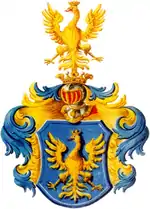Smilovice
Śmiłowice | |
|---|---|
 Lutheran cemetery chapel | |
 Flag  Coat of arms | |
 Smilovice Location in the Czech Republic | |
| Coordinates: 49°39′39″N 18°34′18″E / 49.66083°N 18.57167°E | |
| Country | |
| Region | Moravian-Silesian |
| District | Frýdek-Místek |
| First mentioned | 1448 |
| Area | |
| • Total | 7.85 km2 (3.03 sq mi) |
| Elevation | 390 m (1,280 ft) |
| Population (2023-01-01)[1] | |
| • Total | 848 |
| • Density | 110/km2 (280/sq mi) |
| Time zone | UTC+1 (CET) |
| • Summer (DST) | UTC+2 (CEST) |
| Postal code | 739 55 |
| Website | www |
Smilovice (Polish: ⓘ, German: Smilowitz) is a municipality and village in Frýdek-Místek District in the Moravian-Silesian Region of the Czech Republic. It has about 800 inhabitants. Former Prime Minister of Poland and former president of the European Parliament Jerzy Buzek was born here. The municipality has a significant Polish minority.
Etymology
The village was named after František Smyl, who brought new inhabitants here.[2]
Geography
Smilovice is located about 15 kilometres (9 mi) east of Frýdek-Místek and 25 km (16 mi) southeast of Ostrava, in the historical region of Cieszyn Silesia. It lies mostly in the Moravian-Silesian Foothills, but the southwestern part extends into the Moravian-Silesian Beskids and lies within the Beskydy Protected Landscape Area. The highest point is at 716 m (2,349 ft) above sea level. The Ropičanka stream flows through the municipality.
History
The first written mention of Smilovice is from 1448. It belonged then to the Duchy of Teschen. František Smyl helped to settle the village and brought mainly Romanian Vlachs. For these services, Smyl was promoted to squire and became mayor of Cieszyn. The settlers subsisted on agriculture, pastoralism and mountain farming. In 1603, Duke Adam Wenceslaus sold Smilovice to Hanibal of Brno. Then the village often changed owners. In 1644, the territory where the Řeka community was founded separated from Smilovice.[2]
After Revolutions of 1848 in the Austrian Empire a modern municipal division was introduced in the re-established Austrian Silesia. The village as a municipality was subscribed to the political and legal district of Cieszyn. According to the censuses conducted in 1880–1910 the population of the municipality dropped from 684 in 1880 to 651 in 1910 with a majority being native Polish-speakers (dropping from 99% in 1880 to 96% in 1910) accompanied by a small Czech-speaking minority (at most 15 or 2.3% in 1910) and German-speaking (at most 11 or 1.7% in 1910). In terms of religion in 1910 the majority were Protestants (83.5%), followed by Roman Catholics (14.4%), Jews (9 or 1.4%) and 4 people adhering to another faiths.[3]
After World War I, Polish–Czechoslovak War and the division of Cieszyn Silesia in 1920, it became a part of Czechoslovakia. Following the Munich Agreement, in October 1938 together with the Trans-Olza region it was annexed by Poland, administratively adjoined to Cieszyn County of Silesian Voivodeship.[4] It was then annexed by Nazi Germany at the beginning of World War II. After the war it was restored to Czechoslovakia.
From 1980 to 1990, Smilovice was an administrative part of Hnojník. Since 1990, it has been a separate municipality.[2]
Demographics
Polish minority makes up 18.0% of the population.[5]
|
|
| ||||||||||||||||||||||||||||||||||||||||||||||||||||||
| Source: Censuses[6][7] | ||||||||||||||||||||||||||||||||||||||||||||||||||||||||
Culture
The Christian festival XcamP takes place in Smilovice annually in July since 2001.[8]
Sights
There are no protected cultural monuments.[9] A landmark is the Lutheran cemetery chapel.
Notable people
- Karol Grycz-Śmiłowski (1885–1959), Polish Lutheran and Unitarian priest
- Jerzy Buzek (born 1940), Polish politician, former Prime Minister of Poland
- Stanislav Piętak (born 1946), Lutheran bishop
References
- ↑ "Population of Municipalities – 1 January 2023". Czech Statistical Office. 23 May 2023.
- 1 2 3 "Historie obce" (in Czech). Obec Smilovice. Retrieved 20 February 2022.
- ↑ Piątkowski, Kazimierz (1918). Stosunki narodowościowe w Księstwie Cieszyńskiem (in Polish). Cieszyn: Macierz Szkolna Księstwa Cieszyńskiego. pp. 265, 283.
- ↑ "Ustawa z dnia 27 października 1938 r. o podziale administracyjnym i tymczasowej organizacji administracji na obszarze Ziem Odzyskanych Śląska Cieszyńskiego". Dziennik Ustaw Śląskich (in Polish). Katowice. nr 18/1938, poz. 35. 31 October 1938. Retrieved 1 July 2014.
- ↑ "Population Census 2021: Population by selected ethnicity". Public database. Czech Statistical Office. 27 March 2021.
- ↑ "Historický lexikon obcí České republiky 1869–2011 – Okres Frýdek-Místek" (in Czech). Czech Statistical Office. 21 December 2015. pp. 5–6.
- ↑ "Population Census 2021: Population by sex". Public Database. Czech Statistical Office. 27 March 2021.
- ↑ "O Festivalu" (in Czech). XcamP. Retrieved 20 February 2022.
- ↑ "Výsledky vyhledávání: Kulturní památky, okres Frýdek-Místek". Ústřední seznam kulturních památek (in Czech). National Heritage Institute. Retrieved 2 May 2023.

